|
|
Voltigeur

|
|
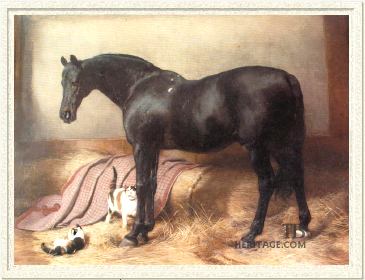 |
|
|
The dominant sire line in Great Britain in the last years of the nineteenth century and the first decade of the twentieth was that of Galopin, St. Simon and St. Simon's sons, Persimmon and St. Frusquin. The patriarch of this potent line was a stallion named Voltigeur.
Voltigeur, foaled in 1847, was bred by Robert Stephenson, who had also bred the sire, Voltaire. Voltigeur was sent as a yearling to the Doncaster sales with a reserve of £300. He was an awkward, stocky youngster with a somewhat weak pedigree. His sire, Voltaire, had been a fairly decent runner, placing second in the St. Leger and winning the Doncaster Gold Cup. He was 21 when Voltigeur was foaled, and had previously sired only one really good animal in Charles the Twelfth, a winner of the St. Leger, the Liverpool Summer Cup, the Doncaster Cup, and the Goodwood Cup, which he won twice. Another son, the promising Yorkshire Lad, died as a two-year-old, but had captured the July Stakes.
Martha Lynn, Voltigeur's dam, was a winner of only three races and had not yet produced anything of any merit. Later, by the time Voltigeur went to stud, she had produced his full sister, Vivandiere, winner of the Yorkshire Oaks. Afterwards, Martha Lynn foaled Vaultress, by Birdcatcher, whose most important victory came in the Fern Hill Stakes, and Maid of Heart, by The Provost, and Eulogy, by Euclid. These latter two half-sisters to Voltigeur became dams of important winners. Eulogy foaled Imperieuse, a winner of the One Thousand Guineas. Maid of the Heart produced Etoile du Nord, a winner of the Prix de Diane; Compiegne, a winner of the Prix Cadran; and Monseigneur, a winner of the Manchester Cup, the Prix de la Foret, and the Grosser Preis von Baden.
But all this was far in the future when Martha Lynn's top-heavy yearling colt entered the Doncaster sales ring. He failed to make his reserve, and so his breeder decided to see if he could sell the colt privately. Not until he was a two-year-old did Voltigeur find a new home. Robert Hill, the trainer for the second Earl of Zetland, persuaded his employer to bring the colt to Aske Hall on loan to the Earl's brother-in-law, Mr. Williamson. He was tried several times against top horses, including Yorkshire Oaks winner Ellen Middleton (1846), Castanette, the good race filly and later dam of Doncaster Cup winner Fandango, and Cantab. When he beat them so overwhelmingly as to be unbelievable in the first two trials, Lord Zetland purchased him for £1500, with a £500 contingency on wins of each of the big races.
Hill was very severe in his training methods, and he galloped the colt in two hoods to try and reduce some of the excess heaviness in Voltigeur's neck. Voltigeur raced officially only once as a juvenile, capturing the Bright Stakes for two year olds at Richmond, in North Yorkshire, before he was put away for the winter.
In 1850 Voltigeur was shipped south to run in the Derby Stakes. Many onlookers were prepared to ignore the invader from the north, especially since he seemed uncomfortable in his first gallop over the Epsom Downs course. However, since the colt had just endured a rigorous train journey from Yorkshire, it was not surprising that he was a little stiff. His next gallop was entirely satisfactory to his connections, but the Earl of Zetland's color bearer still went off at 16-1, which reflected the betting public's skepticism of his form, and no doubt some prejudice against his Yorkshire roots. Voltigeur showed his form was not a fluke when, under Job Marson, he sailed past a fine field, including Two Thousand Guineas champion Pitsford, in time that was ten seconds faster than the three minutes for the mile and a half posted by The Flying Dutchman the previous year.
Voltigeur then returned to his Yorkshire base. The Earl of Zetland and trainer Hill wanted to show the Doncaster faithful just how good their colt was, and prepared to run him in both the St. Leger and the Doncaster Cup, run just two days apart, with an engagement in the Scarborough Handicap in between. it was a brutally ambitious plan, and only a horse of the heartiest constitution and highest class could be expected to pull it off.
The St. Leger proved more difficult than expected. Pitsford was in the field, but it was a tough little Irish colt named Russborough who clung to Voltigeur and actually finished in a dead-heat with the Derby champion. This necessitated a race-off, which Voltigeur won by a length. The next day, Voltigeur enjoyed a walkover for the Scarborough Handicap, and then the next day took the track for the Doncaster Cup. His sole opposition would come from the Earl of Eglington's horse, The Flying Dutchman.
The Flying Dutchman was a talented horse of the highest class. The previous year, he had captured the Derby and the St. Leger, and before the Doncaster Cup, had won the Ascot Gold Cup and a sweepstakes at Goodwood.
The Flying Dutchman conceded nineteen pounds to his younger rival and also had to contend with his jockey, Charles Marlow, who rode a terrible race after a heavy bout of drinking. Voltigeur held off the older horse by a half a length in a race that set the racing pundits talking. many believed that Voltigeur would have won anyway, others felt The Flying Dutchman would have won had he had been able to enjoy the full faculties of his rider. The debate continued over the winter, until finally a re-match was arranged for the following May over the course at York, for a purse of 1000 sovereigns.
|
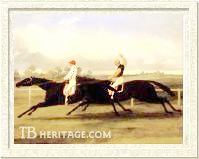
The Famous Doncaster Cup Race
| |
The re-match, over two miles, held on May 13, 1851, was billed as the "Match of the Century." Some people even walked from other northern cities, such as Richmond, just to see the race. The stands were packed with thousands of spectators, and they were treated to a magnificent racing spectacle. Voltigeur, carrying eight and a half pounds less than his rival and under a new partner, Nat Flatman, made all the running until about a hundred yards from home when The Flying Dutchman, under a sober Charles Marlow, ranged alongside the younger horse. The two classic-winning champions raced as a team until The Flying Dutchman finally edged ahead to win by about a length.
|
The Flying Dutchman did not race again, and was retired to stud. Voltigeur did not have that luxury. Trainer Hill kept up the colt's rigorous training, and started him, the very day after the match race, in the Ainsty Hunt Cup. Conceding 37 pounds to a classy filly named Nancy, Voltigeur not surprisingly went down to defeat. But it was hardly an inglorious defeat, as he lost by only a length to a filly which went on to win such important races as the Great Yorkshire Stakes, the Great Ebor Handicap, and the Goodwood Cup during the course of that year.
Finally, given a prolonged rest, Voltigeur was not seen again until the next season, when he was five. He won the race named in honor of his old rival, The Flying Dutchman Handicap, run at York, but then never won again. He finished unplaced in his final three racecourse appearances, including the Ascot Gold Cup, before he was retired to stud.
Voltigeur in the Stud
Voltigeur first stood at Smallwood's stud in Middlethorpe, York for 15 guineas per mare, half the fee charged for Stockwell and West Australian, both of whom were standing in Tadcaster; his rival, The Flying Dutchman, also standing in York, had a fee of 40 guineas. He later was moved to the Earl of Zetland's Aske Hall estate near Richmond, in Yorkshire.
|
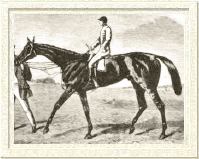
Buckstone won Ascot Gold Cup
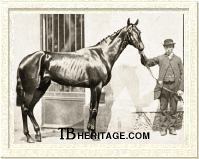
The Ranger won Grand Prix de Paris
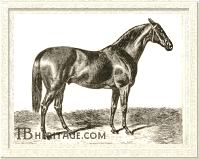
Vedette won Doncaster Cup twice
| |
Voltigeur got such quality animals as BUCKSTONE, a winner of the Ascot Gold Cup; THE RANGER, a winner of the Great Yorkshire Stakes and the Grand Prix de Paris; SABREUR, a winner of the Doncaster Cup as well as the Great Yorkshire Stakes; and SKIRMISHER, a winner of the Ascot Gold Cup. Voltigeur's son BILLET was imported to the United States and was leading sire in North America in 1883. BILLET'S best offspring were his son, Sir Dixon, a winner of the Belmont Stakes, the Travers, and the Withers Stakes, and the champion American filly, Miss Woodford. Sir Dixon was leading North American sire in 1901. Voltigeur's daughter, WOODCRAFT, was only a minor winner, but she produced an Epsom Derby champion in the colt Kingcraft.
Voltigeur's best racing son and his best son at stud was undoubtedly VEDETTE, who was bred by Mr. Chilton from the Birdcatcher mare, Mrs. Ridgway, and sold as a yearling to Lord Zetland. VEDETTE captured the Great Yorkshire Stakes, the Doncaster Cup, which he won twice, and he became his sire's only classic winner when he took the Two Thousand Guineas.
As a stallion, VEDETTE came up with Speculum, a winner of the City and Suburban Handicap and the Goodwood Cup. Speculum also ran third in the Derby Stakes. Speculum was leading sire in Britain in 1878, and counted Derby winner Sefton among his progeny. Both Vedette and his sire, Voltigeur, also got hunters that were "...hard as nails and impossible to tire."
Then came Galopin. Bred by William Taylor Sharpe and raced by Prince Batthyany, Galopin was by Vedette and out of a mare named The Flying Duchess, by Voltigeur's old nemesis, The Flying Dutchman. Galopin captured the Derby in 1875, but it was as a stallion that he truly excelled. He was leading sire in 1888, 1889, and 1898. And he left a son in St. Simon that kept Voltigeur's male line at the forefront of British breeding until well into the twentieth century.
Voltigeur lived to the great age of 27. He lived out his days with a constant companion, a cat, which would spend hours happily sleeping on the great horse's back. On February 21, 1874, the old stallion was put down after fracturing his thigh. |
Several years before his death, Lord Zetland commissioned Sir Edwin Landseer to paint his champion. The Earl asked Landseer to paint his horse first in 1861, and it was not until 1870 that the Earl finally got his portrait of his favorite horse. At one point, he had even offered to have the horse shipped to London for the temperamental artist's convenience, before Landseer finally acquiesced and came north to Aske Hall.
The finished portrait, which can still be seen today at Aske Hall, shows the old horse contentedly looking down at two cats playing in the straw at his feet, one of them obviously being Voltigeur's beloved companion. Also still at Aske are numerous mementos to the champion--a bronze statuette, prints of Voltigeur's racing days by Harry Hall and J.F. Herring, wisps of his hair and a bone from one of the horse's legs. Even to this day, Voltigeur is appreciated for the great racing champion, progenitor, and charming individual he was.
--Elizabeth Martiniak
|
|
|
|

